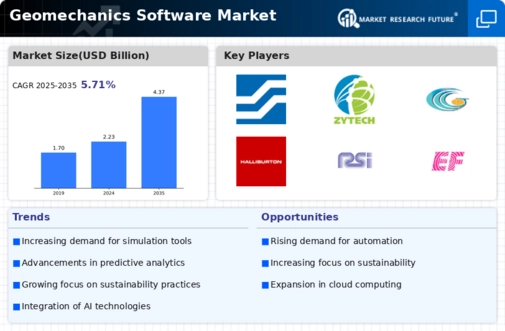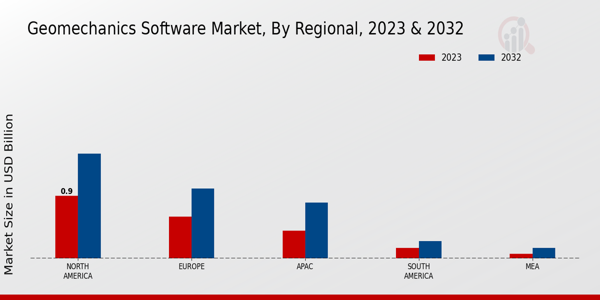Market Growth Projections
The Global Geomechanics Software Market Industry is projected to experience substantial growth over the coming years. With an estimated market value of 2.23 USD Billion in 2024, it is expected to reach 4.37 USD Billion by 2035. This growth trajectory suggests a compound annual growth rate (CAGR) of 6.3% from 2025 to 2035, reflecting the increasing adoption of geomechanics software across various sectors. The market dynamics are influenced by factors such as technological advancements, infrastructure development, and the need for regulatory compliance, all contributing to a robust outlook for the industry.
Regulatory Compliance and Safety Standards
The Global Geomechanics Software Market Industry is significantly influenced by stringent regulatory compliance and safety standards imposed on construction and resource extraction activities. Governments worldwide are enforcing regulations that require detailed geomechanical assessments to ensure public safety and environmental protection. As a result, companies are increasingly investing in geomechanics software to meet these compliance requirements and avoid potential liabilities. This trend is likely to drive market growth, as organizations recognize the necessity of utilizing advanced software solutions to adhere to evolving regulations and maintain operational safety.
Increasing Demand for Infrastructure Development
The Global Geomechanics Software Market Industry experiences heightened demand due to the ongoing infrastructure development across various regions. Governments and private sectors are investing significantly in projects such as roads, bridges, and tunnels, which necessitate advanced geomechanical analysis to ensure structural integrity and safety. For instance, the global market is projected to reach 2.23 USD Billion in 2024, driven by the need for effective risk management and predictive modeling in construction. This trend indicates a robust growth trajectory as infrastructure projects expand, highlighting the critical role of geomechanics software in optimizing design and execution.
Growing Awareness of Environmental Sustainability
The Global Geomechanics Software Market Industry is witnessing a shift towards environmental sustainability, as stakeholders increasingly recognize the importance of minimizing ecological impact during construction and resource extraction. Geomechanics software aids in assessing the environmental implications of projects, facilitating compliance with regulatory standards and promoting sustainable practices. This growing awareness is likely to drive demand for software solutions that incorporate environmental assessments and risk mitigation strategies. As industries strive for greener operations, the integration of sustainability features into geomechanics software may become a key differentiator, further propelling market growth.
Rising Investments in Mining and Oil & Gas Sectors
The Global Geomechanics Software Market Industry benefits from rising investments in the mining and oil and gas sectors, where geomechanical analysis is crucial for safe and efficient operations. Companies are increasingly adopting geomechanics software to evaluate subsurface conditions, manage risks, and optimize resource extraction processes. This trend is particularly evident in regions rich in natural resources, where the demand for reliable geomechanical data is paramount. As these sectors continue to expand, the reliance on advanced geomechanics software is expected to grow, contributing to the overall market expansion.
Advancements in Technology and Software Capabilities
Technological advancements play a pivotal role in shaping the Global Geomechanics Software Market Industry. Innovations in computational modeling, data analytics, and machine learning enhance the capabilities of geomechanics software, allowing for more accurate simulations and analyses. As software becomes increasingly sophisticated, it enables engineers and geoscientists to tackle complex geological challenges with greater precision. This evolution is likely to attract more users, thereby expanding the market. The anticipated growth from 2.23 USD Billion in 2024 to 4.37 USD Billion by 2035, with a CAGR of 6.3% from 2025 to 2035, underscores the importance of these technological advancements.












